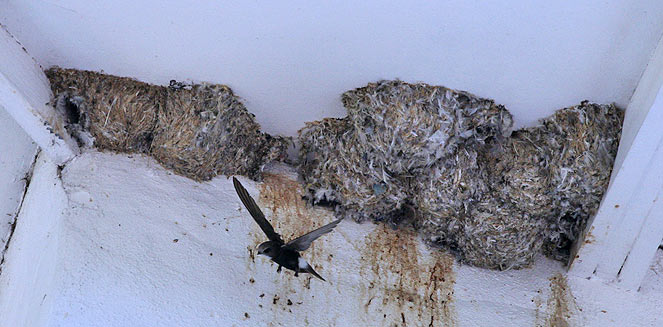|
Apus affinis (Little swift)
Kleinwindswael [Afrikaans]; Sisampamema (generic term for
swallows, martins, swifts and spinetails) [Kwangali]; Lehaqasi (generic term for
swifts) [South Sotho]; Nkonjana (generic term for swift) [Tsonga]; Pêolwane,
Phêtla (generic terms for swifts, martins and swallows) [Tswana];
huisgierzwaluw [Dutch]; Martinet des maisons [French]; Haussegler [German];
Andorinhão-pequeno [Portuguese]
Life > Eukaryotes > Opisthokonta > Metazoa (animals) > Bilateria > Deuterostomia > Chordata > Craniata > Vertebrata (vertebrates) > Gnathostomata (jawed vertebrates) > Teleostomi (teleost fish) > Osteichthyes (bony fish) > Class: Sarcopterygii (lobe-finned fish) > Stegocephalia (terrestrial vertebrates) > Tetrapoda (four-legged vertebrates) > Reptiliomorpha > Amniota > Reptilia (reptiles) > Romeriida > Diapsida > Archosauromorpha > Archosauria > Dinosauria (dinosaurs) > Saurischia > Theropoda (bipedal predatory dinosaurs) > Coelurosauria > Maniraptora > Aves (birds) > Order: Apodiformes > Family: Apodidae
The Little swift occurs almost everywhere in sub-Saharan
Africa, and is often found near built up areas or cliffs, as it uses them as
nest sites. It eats exclusively arthropods, such as termite alates, dragonflies, grasshoppers, Spiders and mantids,
often hunting them at high altitudes. It is a colonial nester, with colonies of
up to 30 nests placed close together. Both sexes build the nest, which is a
untidy closed bowl, made of grass and feathers glued together with saliva. It
lays 1-3 eggs, which are incubated by both sexes, for 20-26 days. The chicks
stay in the nest for 36-40 days, after which they become fully independent.
Distribution and habitat
Occurs across sub-Saharan
Africa, largely absent from Somalia. In southern Africa it is common in Namibia
(excluding the Namib Desert), northern and eastern Botswana, Zimbabwe,
Mozambique, Swaziland, Lesotho and South Africa. It generally prefers built up
areas (with large buildings) or cliffs, rocks and crags, foraging in the surrounding habitat.
|
 |
|
Distribution of Little swift in southern Africa,
based on statistical smoothing of the records from first SA Bird Atlas
Project (©
Animal Demography unit, University of
Cape Town; smoothing by Birgit Erni and Francesca Little). Colours range
from dark blue (most common) through to yellow (least common).
See here for the latest distribution
from the SABAP2. |
Predators and parasites
Food
It exclusively eats arthropods, such as
termite alates, dragonflies, grasshoppers,
spiders and mantids. It hunts in the
air, reaching great heights and travelling long distances in search of food,
while sometimes descending to catch prey fleeing from a bushfire. The following food items have
been recorded in its diet:
Breeding
- Monogamous and usually colonial, with colonies
of up to 30 nests placed closely together. There are two records of it
nesting solitarily.
- Both sexes build the nest (see image below), which is a untidy closed bowl made of grass
and feathers glued together with saliva. These nests are
usually placed in human structures, such as in the eaves of buildings or under
bridges, but it may also use cliffs. It also uses abandoned or unfinished
swallow nests instead of building
its own; species of swallow include
Wire-tailed
swallow, Greater
striped swallow, Lesser
striped swallow, South African
cliff-swallow, Rock martin
and Common
house-martin. Before using the old nest it has to adapt it for its own usage, a process that
takes 2.5-7.0 months.
 |
|
Fig. 3 - Little swift flying from colony. [photo H.
Robertson, Iziko ©] |
- Egg-laying season is from August-September, peaking from
November-December.
- It lays 1-3 eggs, which are incubated by both sexes for 20-26 days. The
parents incubate in 90 minute shifts, sometimes incubating
simultaneously.
- The chicks stay in the nest for 36-40 days, after which they become
fully independent.
Threats
Not threatened, in fact its range has greatly expanded in
the past few decades, largely due to the increasing availability of man-made nest sites.
References
-
Hockey PAR, Dean WRJ and Ryan PG 2005. Roberts
- Birds of southern Africa, VIIth ed. The Trustees of the John Voelcker
Bird Book Fund, Cape Town.
|
